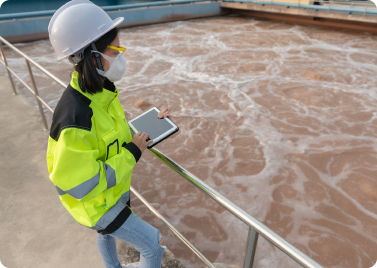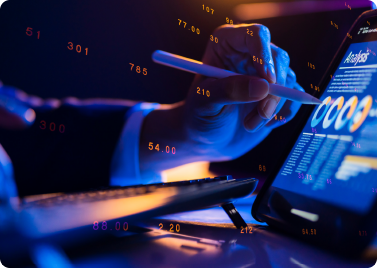Secure and modern asset management: a BRK commitment
The company continually invests in the management of its assets, ensuring the reliability and quality of its water and sewage treatment processes
BRK’s work generates significant benefits for society. Investments in the expansion of networks and in the treatment of water and sewage guarantee practically immediate improvements in people’s health conditions and quality of life. To promote universal access to basic sanitation, the company builds and manages a large complex infrastructure, which requires asset management with maximum efficiency and quality.
BRK’s assets
• 15,184 kilometers of water networks
• 16,627 kilometers of sewage networks
• 385 Effluent Treatment Stations (ETEs)
• 52 Water Treatment Stations (ETEs)
• 30 dams and barrages for water supply
• 2,208 other registered localized units (Elevators, Reservoirs, wells, among others)
• 18,000 registered electromechanical equipment
For each asset category listed above, BRK develops and conducts specific programs for its management. Below is a brief description of each of them.

Effluent treatment
Sewage treatment is carried out at Sewage Treatment Stations (ETEs) managed by BRK’s business units. With the Effluent Monitoring Program, the company monitors the quality of treated effluents to ensure that there are no changes or negative impacts on water bodies.
All units that provide this type of service have a management system that monitors these quality standards, called the LIMS System (Laboratory Information Management System). BRK invests in an oxygen infusion system in the treatment of effluents, which allows a longer period of detention of the element in the tanks of the Sewage Treatment Stations (ETE) and provides a greater exposure of the gas with the microbiology of the activated sludge.
• In 2020, BRK treated almost 246 million cubic meters of effluents.
• Cachoeiro de Itapemirim, a city served by BRK, stands out in the sanitary sewage service – the municipality received the National Sanitation Quality Award (PNQS).
• The average efficiency of effluent treatment is approximately 79.4%.

Water Treatment
Water treatment is carried out at Water Treatment Stations (ETAs) or at Simplified Treatment Units (UTS) operated by BRK’s business units. In compliance with the Sampling Plan, which is based on legal requirements, the company monitors abstraction, treatment and the final product to ensure the safety and quality of the water distributed to the population.
All operational units that have Water Treatment Stations and/or Simplified Treatment Units (specific for water from deep tubular wells) use a laboratory data control system to support quality information management, the LIMS System (Laboratory Information Management System). This system, in addition to internal information control, has an interface with the Ministry of Health’s drinking water quality information system, SISAGUA. Thus, data on the water distributed to the population are automatically sent to the Ministry of Health.

Sewage Collection and Removal Networks
In addition to monitoring the quality of discharged effluent, BRK also manages sewage collection and removal networks to avoid overflows and associated environmental impacts. Control is carried out through the Sewage Overflow Management Program, implemented since 2019. Through this initiative, the company is able to define which places need maintenance most urgently, minimizing the risks of network leakage.
• From 2019 to 2021, BRK reduced the amount of obstructions in sewage collection networks by 23%.
• In 2021 alone, more than 3,600 km of collection networks were preventively cleaned.

Water distribution
To ensure the population’s access to treated water, BRK has an extensive network infrastructure for collection, treatment and distribution. In addition to water availability, efficiency to avoid losses in distribution processes is essential for sustainable business development.
In Brazil, for every 100 liters of treated water, approximately 39 liters are wasted due to leaks. In its operations, BRK works with the Loss Reduction Program. The initiative increases the efficiency of operation and maintenance activities, focusing on the continuous reduction of losses.
One of the main projects to reduce losses is the Water Balance, which consists in sectorization of the distribution network at the municipalities and the installation of meters to monitor the entry and exit of water in each sector. In this way, the company identifies where the biggest deficits are and acts more quickly in corrective actions to identify leaks and provide adequate maintenance of assets.
BRK’s assets
BRK’s goal is to reach a loss rate of 25% by 2030, considering the performance of all units, which currently stands at 35%

Forced Conduit Safety Program
Its objective is to carry out a detailed risk analysis in BRK’s main water supply and sewage discharge lines, identifying critical stretches and proposing mitigation actions, both for risk events that may affect BRK’s operation and for possible consequences that affect third parties in the vicinity of the lines.

Dam Safety
BRK’s asset management also covers actions and control mechanisms to ensure the safety of the dams managed by the company. These structures are essential to guarantee the population’s water supply and the focus of management is the prevention of accidents, such as the overtopping of reservoirs.
The work is guided by the Dam Safety Plan and the Emergency Action Plans (PAE), developed in accordance with the National Dam Safety Policy. These investments serve for continuous monitoring and increased safety and operational reliability.
The monitoring of dams is carried out through digital tools and an online platform, which allows monitoring in real time the technical indicators obtained in regular field inspections. In this way, the company is able to establish action plans for the preventive maintenance of these structures.

Security of Civil Structures
It manages the security of more than 6 thousand civil structures used in BRK’s operations. Its objective is to assess the condition of conservation of the main structures of each SPE, classifying BRK entire structure park according to their need for interventions. In addition, it promotes the training and qualification of local teams on the subject, prepares guidelines and technical manuals to be used by SPEs and promotes new services, products and technologies applicable to the conservation of structures.

Maintenance and Management of Electromechanical Equipment
The management of the life cycle of electromechanical assets at BRK is carried out seeking operational excellence, translated into the balance between cost, risk and performance. The pillars of this management are the continuous search for proactive maintenance, the reduction of operating costs, the increase in the productivity of our teams, the reduction of operational risks and the increase in the useful life of the equipment. The company uses the IBM Maximo platform as a service management tool in its units, providing a unified basis for advancing in the standardization of processes and performance indicators.


















